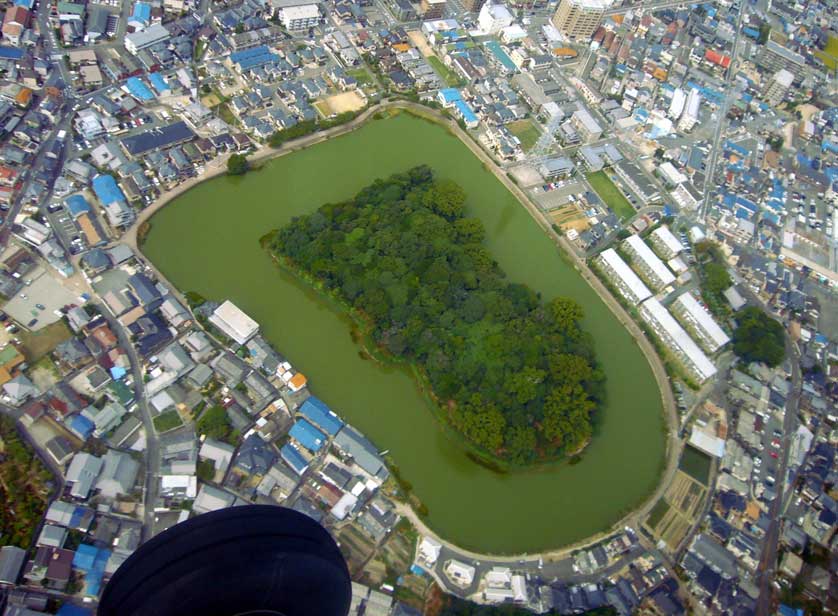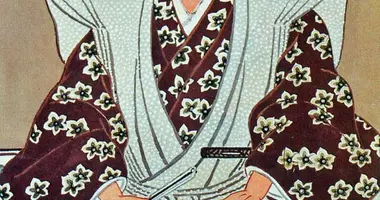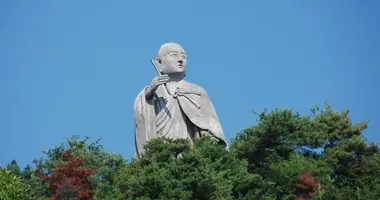Early Japan History Jomon & Yayoi
- Early Japan until 710
- Nara Period 710-794
- Heian Period 794-1192
- Kamakura Period 1192-1336
- Muromachi Period 1336-1573
- Azuchi-Momoyama Period 1573-1603
- Edo Period 1603-1868
- Meiji Period 1868-1912
- Taisho and Early Showa Period 1912-1945
- Postwar Period 1945-Present
History of Japan - Early Japan until 710

Reconstructed Jomon Period raised dwelling or warehouse, Otsuka-Saikachido Archaeological Park, Yokohama
The earliest human settlements in Japan are estimated to date from the Ice Age, about 30,000 years ago. At that time all four main Japanese islands were linked.
The southernmost island of Kyushu was joined to the Korean peninsula and the northernmost island of Hokkaido to Siberia.
Jomon 10,500-300 BC
The first named civilization, the Jomon era, began in about 10,500BC and lasted till about 300BC. 'Jomon' refers to the distinctive rope-pattern decorations on the pottery of the era. The Jomon era itself is divided into 6 stages, the first of which originated on the Kanto plain, around present-day Tokyo.
Jomon pottery predates ceramics found anywhere else in the world by 2000 years and - the people of the time being hunter-gatherers - is unique proof that making pottery was not just the preserve of peoples with agriculture. Similarities in the ceramics strongly suggest contact in late Jomon between western Japan and Korea. Contemporary Chinese accounts of Japan mentioned a fondness for alcohol, and face tattoos to indicate rank.
A recreation of a Jomon site can be found at Sannai Maruyama near Aomori city in Tohoku in the far north of Japan. Sannai Maruyama is the largest Jomon site yet discovered in Japan and was unearthed in the 1990's. At the nearby Komakino Site there are as yet unexplained Jomon stone circles. Many of the artifacts found at the site can be seen in the Aomori Prefectural Folk Museum and at the National Museum in Tokyo.
A recreated six-pillared wooden structure at Sannai Maruyama also remains unexplained and could have been a watchtower of ritual building. There are also excavated Jomon era sites in other northern prefectures including Akita (Oyu Site), Hokkaido (the Ofune site near Hakodate) and Iwate (Goshono site).

Keyhole kofun seen from the air

A model of a Jomon Period hut, Aomori Prefectural Folk Museum, Aomori city

A distinctive goggle-eyed figurine known as dogu. The original is on display at Tokyo National Museum
Yayoi
From the third century BC came waves of the Yayoi people eastward from northern China as the land there began to dry out, eventually forming what is now the Gobi desert. They initially settled in the Korean Peninsula, but were displaced by further waves of immigration from China east to the Japanese isles.
Whether the Yayoi assimilated into Jomon culture, or whether they replaced it with their own is a bone of contention between largely Japanese and non-Japanese historians. The assimilation theory, favored by most Japanese scholars, means that present day Japanese culture is directly linked with the land's earliest inhabitants. The replacement theory, held mainly by Western historians, means the roots of modern Japanese culture were imported.
What is clear is that Japanese society changed crucially with the coming of the Yayoi. Along with rice culture, metallurgy was introduced from Korea. Metal-edged tools allowed the cultivation of drier land, and increased rice production led to a population explosion.
This in turn led to Japan becoming a society of clans, or uji, headed by a male priest-cum-warrior, although women too held important places in the uji. From the late 5th century, uji were subdivided into be and tomo, roughly corresponding to guilds.
Under this system groups worked the land to support the bronze and iron specialists, or the builders of that era's giant key-shaped burial mounds, or kofun.

A Yayoi Period jar in Tokyo National Museum, Ueno, Tokyo

Reconstruction of a Yoyoi watchtower, Yoshinogari site, Saga, Kyushu.

Izumo Yayoi-no-mori Museum pottery exhibits, Shimane Prefecture
Divine incarnations of the forces of nature, or kami, were the focus of daily activity, and a conquering uji would incorporate another uji's kami into its pantheon, the pantheons thus coming to represent the hierarchy of the uji. Life was primitive with clothes made of hemp or bark and with no writing or monetary system. The territorial conflicts and acquisitions between the uji gradually led to the founding of a state in the third century BC dominated over from present-day Osaka, or Yamato. The Court came to be dominated by the Soga clan whose leaders served as financial administrators and diplomats. The Soga also provided consorts and wives to the Imperial line.
Kofun Period
Under the Soga a new wave of cultural influence hit Japan in the 6th century AD. The kofun burial mounds from that time suddenly began being filled with weapons - not just mirrors and jewels. This indicates that a militarized aristocracy had come into the ascendant. At this time Korea was at its cultural peak despite - or thanks to - being split into three feuding kingdoms. The kingdom facing Japan, Paekche, formed a strategic alliance with Japan. As part of the deal it made some revolutionary inputs into Japanese history, namely:
- a stream of various craftsmen, among them metal workers who introduced more sophisticated armor and weapons
- Buddhist treasures
- a scholar who taught writing and Confucian thought.
With the political state of things in Korea, Japan had gained control of some territory. However late in the same century, with the breakdown of the alliance, a huge number of Koreans who had been living on Japanese territory migrated to Japan.

Horyuji Temple in Nara was built during the Asuka Period and shows clear influence from the Buddhist art and architecture of China and Korea
Asuka Period
In Japan in 587AD the Soga clan was victorious in a civil war defeating its rivals the Mononobe and Nakatomi clan and heralding the formal acceptance of Buddhism which it had overseen the introduction of from the mainland. In 593 Empress Suiko ascended the throne, proclaimed her acceptance of Buddhism, and encouraged the building of temples in what is now known as the Asuka district, about 25km south of Nara.
Until deposed in 645 the Soga, along with their devoutly Buddhist ally Prince Shotoku (AKA Shotoku Taishi, 573-621), began legitimizing their rule over the surrounding (restless) clans by way of Chinese institutions. This involved sending great numbers of envoys to China to study its systems, thinking and culture while reorganizing the Court along Chinese lines. The process culminated in the issuance in 604AD of the 17-Article Constitution that recomposed the state on Confucian grounds, and elevated the head of the Yamato to semi-divine tenno, or Emperor, who presided over the land.
Prince Shotoku died in 622 and excessive ambition in the Soga leaders led to the clan's demise in a gory succession struggle in the early 640s. Emperor Kotoku ascended the throne in 654 and, free of Soga influence, moved the Court out of Soga territory to Naniwa (present day Osaka). (His right hand man, Fujiwara Kamatari, was the leader of one of the two clans the Soga had defeated, the Nakatomi. He founded a new clan, the Fujiwara, that would rise to dizzying heights of wealth and power for centuries to come.) Furthermore, in 646 Emperor Kotoku began the Taika Reform, reinforcing the power of the throne by further pursuing the trend of sinofication. The major reforms were to:
- posit the court as actual owner of the land (Japan's basic source of wealth) and people
- introduce a new centralized tax system
- transfer clan power to the throne
- establish a rule-abiding bureaucracy
- adopt the Chinese calendar
This process continued for the rest of the century and culminated with the promulgation of the Taiho Code which was almost a carbon copy of the Chinese T'ang dynasty system of government. An intricate system of national government known as ritsuryo was put in place. It posited basic equality, treating all land and persons as "public property".
The crucial difference was that whereas the T'ang system was based on the preeminence of virtue and merit (i.e. the 'mandate of heaven') in organizing society, which formed the "carrot" that counteracted the "stick" of heavy taxes, the Japanese clung to a hierarchy based on birth, not talent - a lopsidedness that doomed it to failure.
Regular missions to China to learn more about Buddhism and political institutions continued until 839. The first state university was founded in 647 in Nara, headed by a Korean priest. This reflects the pivotal role of specialist Korean immigrants (toraijin) in bringing Chinese culture to Japan during the Asuka period, creating a Buddhist inspired culture late in the period known as the Hakuho culture.
Otsu (Omikyo) in Shiga Prefecture briefly served as the capital of Japan from 667 to 672 AD during the Asuka period. The capital then moved back to Asuka, before moving again to Fujiwara-kyo (present-day Kashihara in Nara Prefecture) between 694 and 710.
Accommodation in Nara
Books on Japanese History
Court and Bakufu in Japan: Essays in Kamakura History
The Mongol Invasions of Japan, 1274 and 1281
A History of Japan: From Stone Age to Superpower
A Modern History of Japan: From Tokugawa Times to the Present
Books on the History of Japan
Jomon Period: Read about the history of Japan to 710 A.D including the Jomon and Yayoi periods. Later came the Kofun Period and then the foundation of a state based on the acceptance of Buddhism during the Asuka Period.









